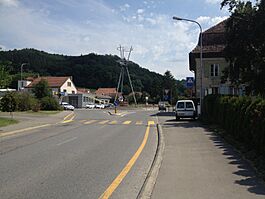Marnand facts for kids
Quick facts for kids
Marnand
|
||
|---|---|---|
 |
||
|
||
| Country | Switzerland | |
| Canton | Vaud | |
| District | Broye-Vully | |
| Area | ||
| • Total | 2.26 km2 (0.87 sq mi) | |
| Elevation | 477 m (1,565 ft) | |
| Population | ||
| • Total | 158 | |
| • Density | 69.9/km2 (181.1/sq mi) | |
| Postal code |
1432
|
|
| Surrounded by | Châtonnaye (FR), Granges-près-Marnand, Henniez, Trey, Villarzel | |
Marnand was once a small town, or municipality, in Switzerland. It was located in the canton of Vaud, within the Broye-Vully area.
On July 1, 2011, Marnand joined with several other towns. These included Cerniaz, Combremont-le-Grand, Combremont-le-Petit, Granges-près-Marnand, Sassel, Seigneux, and Villars-Bramard. Together, they formed a new, larger municipality called Valbroye.
Contents
History of Marnand
Marnand is a very old place. The first time it was ever written about was in the year 1142. Back then, its name was spelled Marnant.
Geography of Marnand
Marnand covers an area of about 2.26 square kilometers (0.87 square miles). Much of this land is used for farming. About 58% of the area is farmland, where crops are grown or animals graze.
Forests cover a good portion of Marnand, about 30.5% of its land. The remaining 11.1% of the land is developed. This means it has buildings, roads, and other structures. A very small part, less than 1%, is made up of rivers or lakes.
Marnand is located next to the Broye river. It sits on the right side of the river. The Rioz river also flows into the Broye river right there.
Marnand's Coat of Arms
Every town has a special design called a coat of arms. Marnand's coat of arms is split into two parts. The top part is silver and shows two snails facing each other at the bottom. The bottom part of the shield is green.
People of Marnand
In 2009, Marnand had a population of 158 people. Over the ten years before that, the number of people living there grew by about 9%. This growth was partly because new people moved in and partly from births.
Most people in Marnand speak French. In 2000, about 92.4% of the people spoke French. A smaller number of people spoke Portuguese (2.8%) or German (2.1%).
In 2009, about 10.2% of the people were children aged 0 to 9 years old. Teenagers, aged 10 to 19, made up about 11.5% of the population. Most adults were between 20 and 49 years old. About 13.4% were in their 20s, 17.2% in their 30s, and 21% in their 40s.
The population of Marnand has changed over time. For example, in 1764, there were 87 people. By 1900, it had grown to 248 people. In 2000, the population was 145.
Economy of Marnand
In 2010, the unemployment rate in Marnand was 5.5%. This means that 5.5% of people who wanted to work could not find a job.
Many people in Marnand worked in farming. This is called the primary economic sector. In 2008, 32 people worked in this area. There were also jobs in the secondary sector, which includes manufacturing and construction. The tertiary sector includes jobs like sales and services.
In 2000, 65 people from Marnand had jobs. About 35.4% of these workers were women. Many people who lived in Marnand traveled to other towns for work. About 53.8% of workers used a private car to get to their jobs.
Religion in Marnand
In 2000, people in Marnand followed different religions. About 26.9% of the population were Roman Catholic. A larger group, about 56.6%, belonged to the Swiss Reformed Church. A small number of people belonged to other Christian churches or to Islam. About 7.59% of the people said they did not belong to any church.
Education in Marnand
Education is important in Marnand. In 2000, about 36.6% of the people had finished upper secondary education. This is schooling after elementary and middle school. About 5.5% had gone on to higher education, like a university.
In the 2009/2010 school year, there were 21 students in the Marnand school district. The local school system provides two years of optional pre-school. There were 13 students in the primary school program, which lasts for four years. For middle school, which lasts six years, there were 7 students.
See also
 In Spanish: Marnand (Vaud) para niños
In Spanish: Marnand (Vaud) para niños




